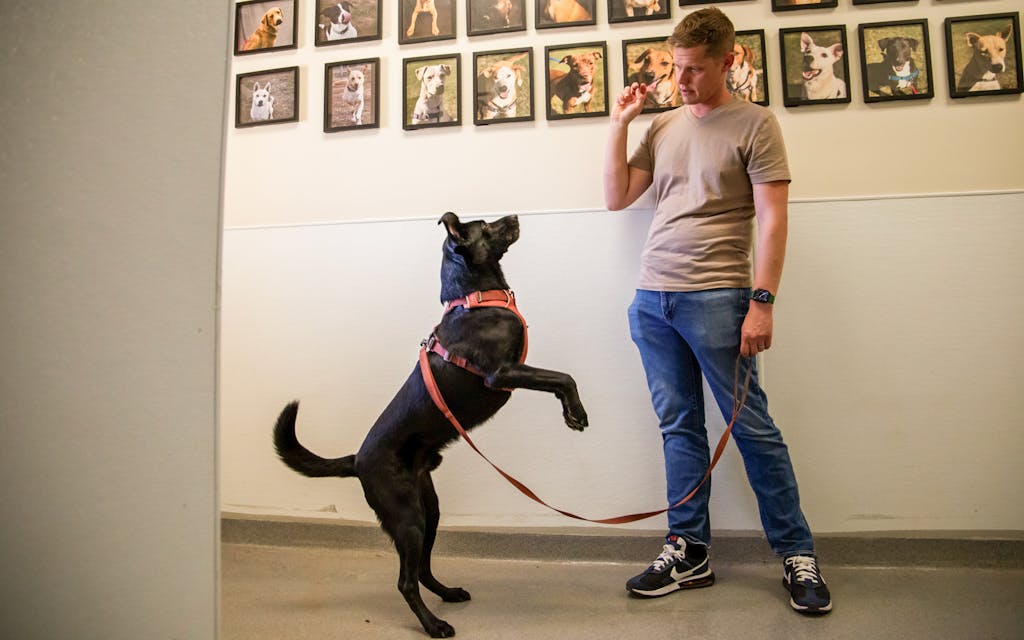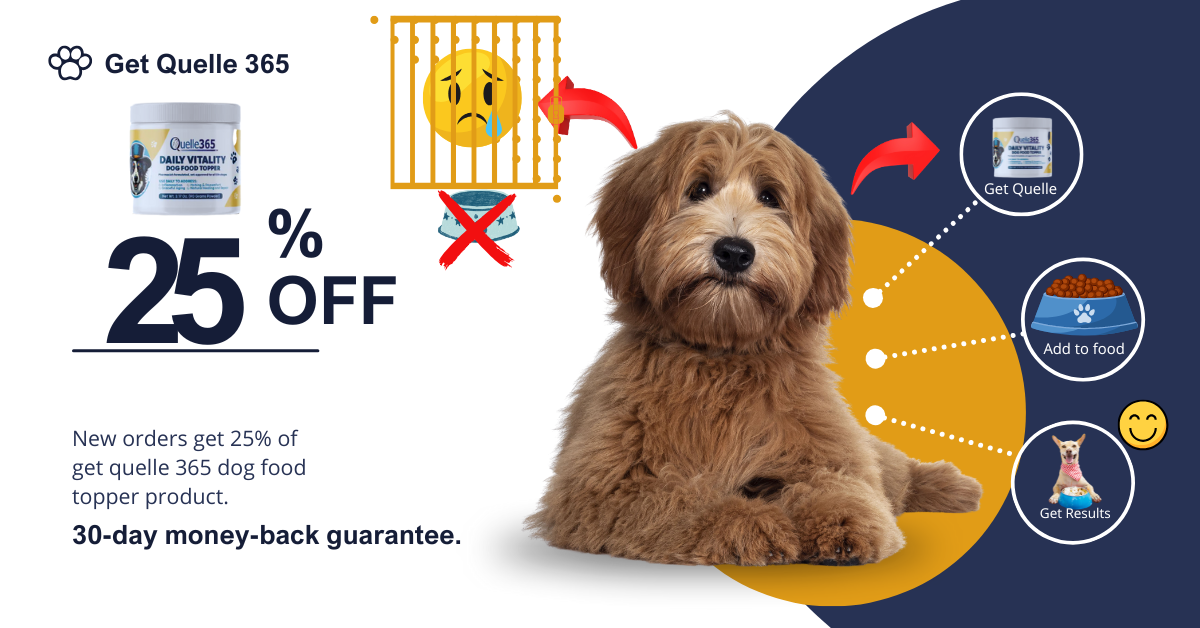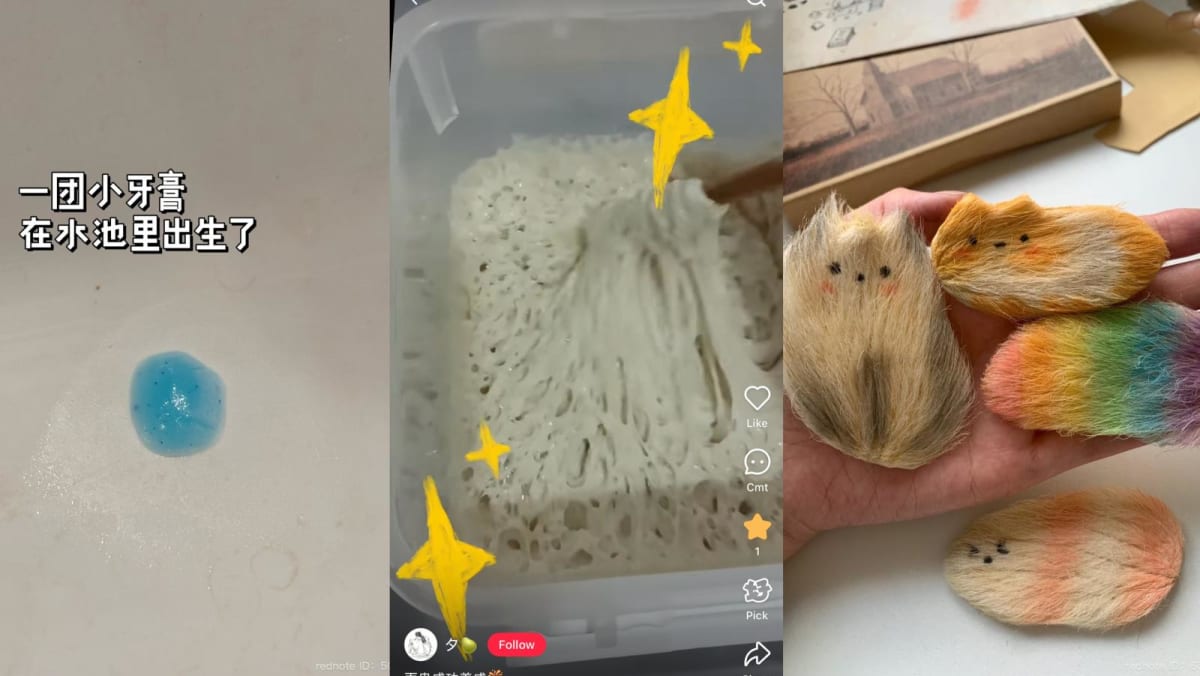Two and a half years ago, at the ripe old age of one, Charlie found his calling. Before that spring day in 2021, the German shepherd and golden retriever mix had been cooling his paws inside an animal shelter in Lubbock alongside a multitude of other dogs that had been lost but not yet found. Day after day Charlie was overlooked as his compatriots were whisked away to new owners. Then, just when Charlie thought he’d never be adopted, it happened. Someone had finally called on Charlie; the pup with a black-and-brown coat and a white muzzle would find his own happy home after all. But this adoption arrangement would be rather unusual—instead of a humdrum life of padding laps around a cul-de-sac and protecting front doors from letter carriers, Charlie would be joining a cutting-edge research team. Unbeknownst to the energetic mutt, he’d just donated his body to science. Well, not all of it. Just his nose.
Charlie was loaded into a van and delivered to his new digs, a Texas Tech University research facility just north of Lubbock in the rural farming community of New Deal. The Canine Olfaction Research and Education Laboratory, a nondescript building with tan metal siding, sits at the east end of an agricultural research complex on land formerly used for cotton farming. A researcher led Charlie past an entryway whose walls were adorned with framed portraits of grinning pups. The halls bustled with activity, as researchers and their dogs—some of whom were outfitted with heart rate monitors and radio frequency tags to measure their movements—walked from room to room to take part in daily experiments. At the center of it was the person responsible for his rescue: Nathaniel Hall, an associate professor of companion animal science who came to Texas Tech in 2016 to push the boundaries of dogs’ spectacularly sensitive noses. As the lab’s director, he’s led experiments introducing the animals to such wide-ranging smells as ammonium nitrate (a bomb-making ingredient) and amyl acetate (banana). Hall’s work suggests that we’ve barely scratched—and sniffed—the surface of what dogs’ noses are truly capable of. “Theoretically, there could be an upper limit, but we haven’t reached it yet,” Hall said.
Each semester, Hall and his team of graduate students and research assistants recruit eight dogs from the Haven Animal Care Shelter, housing them at the lab while studying their physiology. The team runs a range of canine experiments, but the most intriguing have to do with dogs’ olfactory sense, or their ability to perceive various odors. (After their semester of work is over, most of the dogs are adopted by local families. The few that aren’t remain at the lab or, in at least one case, find a home with a staff member.) They’re trained as detection dogs, a subset of working dogs that includes hunting dogs, police dogs that sniff for drugs, and cadaver or search-and-rescue dogs. But Charlie and his labmates aren’t doing any of those jobs. Instead of tracking prey or catching criminals, they’re learning to be conservationists by sniffing out invasive species, agricultural pests, and hazardous pollutants. It’s still rare for dogs to be trained in this kind of work, but Hall believes the niche holds great potential. “Dogs across the country could be leveraged for these types of tasks,” he said.

Hall’s experiments have concluded that dogs can reliably sniff out zebra mussels, an invasive species that has disrupted native aquatic life and sliced swimmers’ feet in reservoirs statewide. The Tech team has also trained their charges to find the eggs of the spotted lanternfly, a non-native plant hopper that has decimated trees in the northeastern United States. (The species hasn’t yet arrived in Texas, but that could change.) In that experiment, dogs were able to detect lanternfly egg masses hidden inside wooden pellets with a success rate of 95 to 99 percent. In collaboration with researchers at Virginia Tech University, the Texas Tech team taught 150 volunteers how to replicate the detection training, putting their own pets on the front line of the spotted lanternfly war. More than half of those dogs in training have already completed their initial certifications for scent work.
Someday, Hall hopes, enough dogs will be trained for conservation detection work that folks who need one can simply place an order and wait for a dog to arrive, à la Uber or GrubHub (PupHub?). Such a platform would be handy for farmers, scientists, or agricultural agents. “We have this crazy pipe dream,” Hall said. “Say you’re a farmer somewhere in West Texas,” and you notice that something is eating all your cotton plants. “You log into your dog detection app,” which would summon someone who has trained their dog to find that target in your region. “You have immediate confirmation right then and there that you’ve got an issue,” Hall said.
Humans have been harnessing the power of dogs’ noses for thousands of years. Ancient Romans hunted with the vertragus, an ancestor of the modern greyhound, and in medieval England, bloodhounds helped chase down wild boar and deer. But the idea of utilizing dogs for conservation tasks has only been kicking around for about a decade or so, Hall said. It’s catching on quickly and may be the most important discovery in modern dog training since the 1970s, when police agencies began teaching canines to find cadavers. The power of dogs’ noses is now being used to detect any number of environmental problems in Texas and beyond: leaking sewer and gas lines, the bodies of birds and bats killed by wind turbines, logs infested with the eggs of the emerald ash borer, heavy metals underneath shorelines, and even the mysterious prion disease that causes chronic wasting disease in deer. In the realm of science, there are few universal truths. But here’s one: A dog can be trained to find literally anything, so long as it has a smell.
Charlie, the erstwhile stray, has developed his own niche ability in the two years since his stay at the Olfaction Lab. Now three years old, Charlie has learned to smell powdery mildew, a fungal disease that attacks grape plants and can wipe out entire vineyards. Powdery mildew infestations are a frequent source of consternation for the Texas wine industry, which produces 4.3 million gallons annually, the fifth-most of any U.S. state. Thanks to his training, Charlie could be an answer to a worried winemaker’s prayers—he can smell the fungus spreading on grape leaves before it’s visible to the human eye. In a laboratory setting, Hall said, Charlie can discern powdery mildew with a success rate that approaches perfection. He is now the most highly trained powdery mildew dog in the world, one of the only canines capable of catching outbreaks before they spiral out of control. Everyone wins—especially Charlie, who is rewarded with a piece of kibble each time he does a good job. And Charlie, being a very good boy, gets a lot of kibble.
Over the years Hall has managed to cultivate a group of partners and collaborators to help carry out his wide-ranging experiments. One of his most consistent collaborators has been Paul Bunker, a San Antonio–based dog trainer with four decades of experience. Last year Hall and Bunker teamed up to determine whether dogs could be trained to detect crude oil spills under Texas beaches. Hall’s research showed it was not only possible for dogs to smell freshly leaked oil underground, but that they could also distinguish the smell from that of the washed-up tar balls swept onto the beach after a previous oil spill. Bunker took two dogs down to the coast near Corpus Christi to conduct (successful) field tests. “With people like Nathan, you work on super interesting projects,” Bunker said. “I’ve seen a massive, hundred-eighty-degree change compared to when I started dog training. And it’s still evolving, just the amount of research going on to try to understand what dogs can do.”
Bunker, who trained with the Royal Army Veterinary Corps and later led canine detection units at naval bases in Missouri, North Carolina, and at San Antonio’s Lackland Air Force Base, retired from military work in 2017 and went solo, opening his own detection-dog company, Chiron K9. He’s had no shortage of business and recently hired his first employee. “It has to be the fastest growing use of detection dogs in the world,” Bunker said of conservation-dog work. “The more people who are seeing it in the news—ecologists, biologists—the more people are getting involved.” The dogs he trains have already demonstrated remarkable feats of olfaction, especially for Texas zoos engaged in conservation work. For the San Antonio Zoo, his dogs sniffed out signs of Texas horned lizard activity in Bexar and surrounding counties; their findings were key evidence to the zoo’s efforts to help the threatened lizard’s populations rebound at relocation sites throughout Texas. In 2020, the Fort Worth Zoo asked Bunker if he could train a dog to sniff out the critically endangered Anegada rock iguana in the Virgin Islands. Soon after, Bunker trained and delivered the dog—it found its first iguana hatchling last year.
In late September, Bunker had just returned to South Texas from Laos, where he endured a bout of dengue fever while training two dogs to track down the reclusive saola, a forest bovine known as the Asian unicorn. It’s one of the world’s most-endangered mammals. “They haven’t been seen for ten years,” Bunker said. “And even then, there were only seven discovered.” The dogs aren’t being trained to find the saola themselves; rather, they’re looking for their scat, which could hold valuable clues after ongoing DNA testing. The problem is that the rarest mammal in the world also has the rarest poop in the world, and the dogs haven’t found any yet. For now, the dogs are being trained to determine which scat doesn’t belong to the saola, in the hopes that someday they’ll find some that does.
Bunker stresses that the dogs’ health is his top priority. He teaches an advanced canine medic course for other dog handlers and holds safety briefings for any other handlers who may be working on a project. His dogs are equipped with microchips that allow him to monitor their temperature—crucial information when they’re working in the South Texas heat. “You’re a caretaker first, then a trainer, then a handler, in that order,” he said. “This ensures that the health and welfare of the dog is put first.”
That same ethos rings true at the Olfaction Lab. In the building’s entryway is a photo array of the program’s forty “Ph.Dog Graduates,” including recent grads with names such as Ranger, Phoebe, R2D2, and Norma and Norman (no relation). Athena, a boxer-mix with a golden coat, is another favorite. “Athena went to a family with little kids,” said Sarah Kane, a graduate student in the university’s animal sciences department. “They sent us a picture, like, a week later, and all the kids were playing doctor with Athena, and she was laying there. It was very cute.” Each university semester is followed by an adoption event for program graduates, typically in December and June. Adoptees can take home a highly trained detection dog and are also given a folder explaining their new dog’s skills and training plans. Charlie likely would have been adopted at one of these events, but he was snapped up by Kane, who begrudgingly fell in love with the pup when he first arrived. She still brings him to work occasionally to participate in experiments and socialize with other dogs. “He is very smart and very obnoxious, and that’s a combo that I love,” she said. “He’s saucy. That’s a good word for it.”









